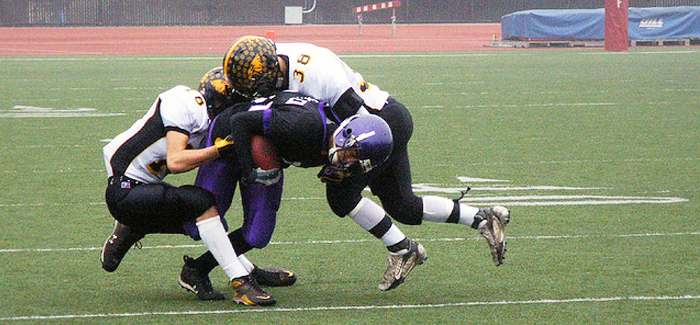
The jarring truth is that knowledge about head injuries remains foggy. (Photography by juicyrai, CC BY-NC-ND 2.0)
At a conference on concussions, many questions and few answers.
Doctors—especially specialists with decades of experience—are supposed to know. Yet again and again, speakers at the conference Mild Head Injury, Concussion, and Return to Activities, held in January at the Gleacher Center, voice variations on the same theme: “We don’t really understand.” “There’s no data.” “Everyone thinks they’re right but nobody knows.” Organized by David Frim, professor of surgery and pediatrics and chief of neurosurgery, and Julian Bailes, chair of neurosurgery at NorthShore University HealthSystem, the conference was intended for a broad range of health professionals—neurosurgeons, emergency room physicians, pediatricians, physical therapists, as well as coaches and physical education teachers.
“If you remember one thing, remember this: concussion spectrum,” says the first speaker, Ann-Christine Duhaime, a pediatric neurosurgeon at Massachusetts General and a Harvard professor. “What is a concussion? It depends on who you ask.” Early studies of concussion took a biomechanical approach, she explains, assuming that a head injury was determined by the type, direction, and magnitude of the force. But recent research has undermined that assumption.
In her four-year study of football, men’s hockey, and women’s hockey at three colleges, the goal was to determine if there is a biomechanical threshold for concussion and if forces can predict outcomes. The athletes suffered almost half a million impacts, she says. Yet just 48 players were concussed: 40 in football and eight in hockey, of whom seven were female. One unexpected finding, Duhaime says, was that some of these injuries “had no specific identified impact.” Another surprise was that only half of the patients had immediate symptoms, and very few of these symptoms could be observed by others.
As for forces, there was a wide range and no obvious threshold. “Are subconcussive hits equally important?” she says. “Maybe you can get symptoms from repeated subconcussive hits. … Do the symptoms matter, or do the forces matter? Or maybe it has to do with your genes.”
Deciding when an athlete should return to play is just as nebulous. You want to prevent three things, Duhaime says: second impact syndrome (a rare but serious condition that can cause death) in the short term, exacerbated or persistent symptoms in the medium term, and permanent cognitive deficits in the long term. But there is no evidence that waiting to recover completely prevents second impact syndrome. “We don’t understand if physical or cognitive rest makes sense” in preventing persistent symptoms. And “we just don’t know” what causes permanent damage, she says. “How many hits is too many? Too many of what?”
Next up is Elizabeth M. Pieroth, clinical neuropsychologist at NorthShore. “Neuropsychology has a long history of research on concussion, starting with the 1970s on boxing,” she says. “We were the first to use college athletes as a natural experiment.”
To assess her patients, Pieroth relies on interviews and neuropsychological tests—but there is little correlation between the two. “Athletes are not always truthful,” she says. “One part of my job is people lying directly to my face. Particularly girl soccer players.” Sometimes they’re being deliberately untruthful: an athlete understates her injury because she doesn’t want to let the team down. Sometimes they aren’t; for example, an athlete who doesn’t realize that sensitivity to light is a symptom. Testing also finds impairment in patients who seem symptom-free. “Physical and cognitive symptoms usually recover together,” Pieroth says, “but not always.”
The cognitive tests look at attention, memory, language, visual-spatial processing, and sensory motor skills, among other factors. While there are literally hundreds of different tests, both paper based and computer based, “most tests are designed to catch the big things—gross abnormalities,” she says. But “concussion is subtle.”
Pieroth lists various factors that can delay recovery, including age (younger children recover more slowly), gender (girls recover more slowly), ADD or learning disabilities (“these kids’ brains are wired a little differently”), and depression or anxiety. “We talk a lot about return to play, but not return to learn,” says Pieroth, who advocates getting young people back into school as soon as possible. “Microscopes, whiteboards, and hallways are difficult for kids” with concussions, she says, but there are simple solutions. If navigating crowded hallways is a problem, for example, a student could be given permission to leave class three minutes early.
During the lunchtime panel discussion, attendees have a chance to ask their own questions, including the most basic: how do you know when to clear an athlete to return to play? Frim’s stark answer: “There is no way we can clear someone to go back and play football,” he says. “It is an inherently dangerous game. So is hockey. So is soccer.” But sports have advantages that counterbalance the risks, he adds: athletes tend to get better grades and more sleep than nonathletes; they can benefit from a close relationship with their coach.
How about “brain rest,” a common concussion treatment that limits physical and intellectual activity? “The brain is just as metabolically active when you’re asleep as when you’re doing calculus,” Duhaime says. “Brain rest doesn’t make sense metabolically.”
How many concussions are too many? Even a reasonable assumption—that children who have multiple concussions are at a higher risk for future injuries or long-term complications—is unproven, says Frim. “Are they at a higher risk of injury than their peers? We have no data to answer it with. … Is CTE [chronic traumatic encephalopathy] started by early concussions? There are so many questions we can’t answer.”
As for whether kids should play these sports at all, “It’s a personal decision; everyone has a comfort level with risk,” says Pieroth. She recommends thinking in terms of risk stratification. “If you’re a hundred pounds and five two, don’t play football. Don’t play on three different travel teams.”
